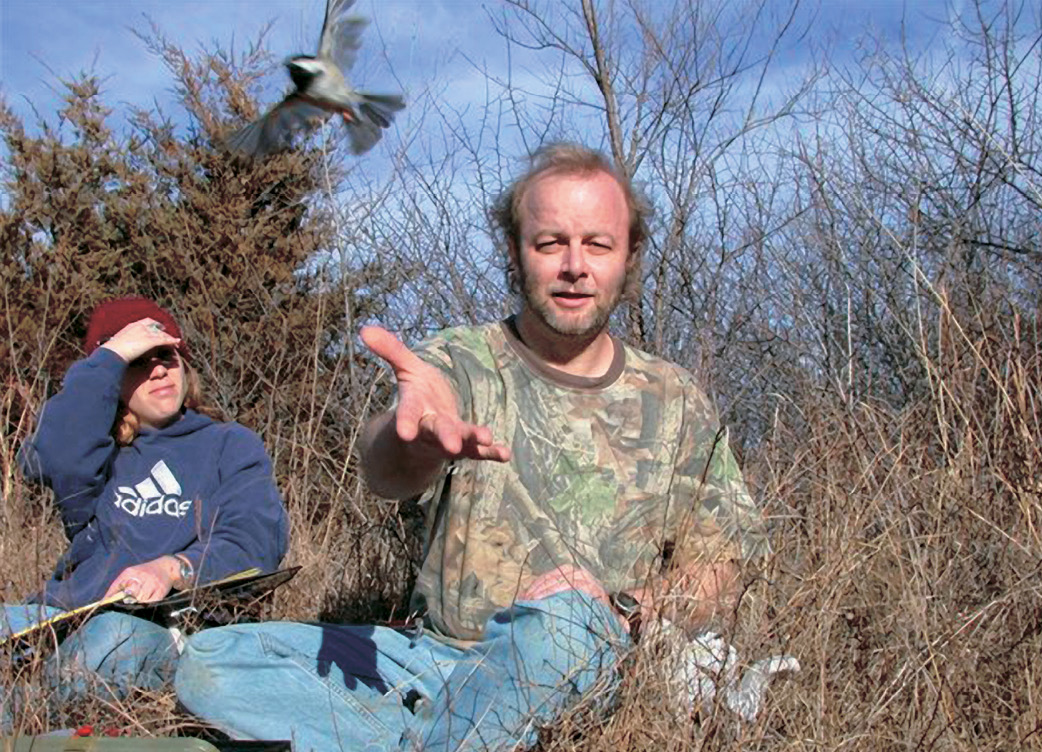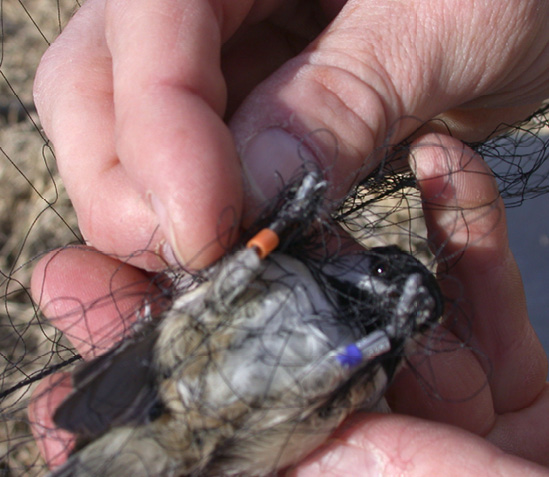
Chris Rogers is an unabashed enthusiast and student of nature — "Every chance I get, I head out of doors," he says — but he's no mere dewy-eyed tree-hugger. Early on, this assistant professor of biological sciences chose birds as his passion, and in Hubbard Hall or, more usually, at WSU's 330-acre biological research station, Rogers is investigating issues of critical significance to avian biology and, by extension, to the larger world.
The opportunity for field studies the site provides was a major reason Rogers came to WSU in 2000. Don Distler, associate professor of biological sciences and a virtual research station resident, remarks, "Chris had all sorts of projects in mind, and he hit the ground running, or, rather, hit the air flying!"

mist-net. Chris Rogers is involved in a number of field
research projects, including an ongoing bird-fat study
and a study of levels of the West Nile virus in three
bird species.
Flanked on the east by the Ninnescah River and comprising restored native tallgrass prairie, woodlands and intermittent streams and wetlands, the research station is home or hotel to dozens of bird species.
It's also the home away from home for Rogers and several Wichita State students who can stand up to the rigors of frequent and lengthy exposure to Kansas weather. Last winter, they began an ambitious project: to determine what roles bird migration and non-migration play in the spread of West Nile virus.
"A person is as likely to be infected with West Nile as they are to be struck by lightning," comments Thomas Shelite '03, graduate student and member of Rogers' team. "Birds are actually much more vulnerable to the virus than we are." However, people naturally respond self-interestedly to this health threat.
But for environmentalists, the health of birds is as important as the health of people. "We're all in this together," Rogers says. "Like any other ecological component, birds have a part to play in maintaining the soundness of any ecosystem, as do we." Birds are prime agents for seed dispersal and for controlling insect and rodent populations, both of which are important factors in environmental equilibrium.
"Crows and bluejays were the first to get West Nile," Rogers points out, "but in the last five years we've found 100 infected species." He decided to study two species of migratory birds — the yellow-rump warbler that travels to the United States in the spring from its breeding grounds high on the slopes of the Andes, and the American tree sparrow, which travels north in the winter to breed on the Alaskan tundra — and the non-migratory northern cardinal. WSU's research station lies fortuitously below the routes traveled by many such migratory birds. "We have a north-south strip of woodland," Distler explains, "that's an ideal rest stop for a variety of migratory birds." And that facilitates a bonanza of research opportunities.
Rogers and his students are safely mist-netting birds, gently extricating members of the three chosen species, banding them for identification purposes the next time they travel through the area, collecting blood samples to analyze against future samples from the same birds, and releasing them. "We're looking for an overall prevalence of the virus, and whether there's an increase in that prevalence, in two populations of widespread migratory species that winter and breed in North America," explains Rogers. "If there's an increase in the virus level, that tells us that the background ecological level of the virus is increasing."
The northern cardinal — the single non-migratory species in the marked population — is being studied to determine if the stress associated with breeding increases the background levels of the virus. "We want to find out if living year-round in one place increases the likelihood of their being bitten by mosquitoes, which would amplify the virus in the given location," says Rogers. A similar question applies to the two migratory species. "They migrate through and breed in wetlands, like those at the research station," comments Shelite, "where of course there are more mosquitoes."
While Rogers is concerned about the impact of West Nile virus on birds and the larger environment, his work also is relevant to public health. "People become exposed to disease through what we call environmental reservoirs," says David McDonald, professor and chair of the department of biological sciences. "Birds are a reservoir. A mosquito that feeds on an infected bird and then bites a person transmits the virus, which allows it to maintain itself in the environment." Rogers is also investigating whether a species' susceptibility to the virus changes. According to McDonald, "Chris is discovering that some birds may get infected but not die. That's not a good thing. An asymptomatic carrier is a reservoir and therefore a potential danger to people."
Ultimately, the larger issue is whether asymptomatic carriers, migratory or not, increase human susceptibility to
the virus.
Distler comments, "Chris is passionate and practical about his work, and he has a remarkable ability to bring a fresh perspective to any study, to ask really new questions. He's not merely going through the motions of research just to notch up his credentials, he's trying to make a difference." Convinced of the value of Rogers' research, the Kansas Biomedical Research Infrastructure Network awarded him a $35,000 grant from its National Institutes of Health funding toward the study, and he also received $4,500 through WSU's Research/ Creative Projects Award program.
This summer, Rogers is doing further research at Michigan State University's Kellogg Biological Station on another of his ongoing passions: the conservation of endangered avian species. He's studying the cerulean warbler, which breeds in the forests of eastern North America but winters in the Andes. "Their population has declined precipitously since 1966, at a rate of 4 percent a year," he notes. "We need to find out why." In reference and deference to Aldo Leopold, one of America's pioneering environmentalists, Rogers declares, "If we can save the cerulean warbler, we are practicing a sound land ethic in the best Leopoldian sense. If you take care of the land, you take care of yourself."
And that's a cardinal virtue.





